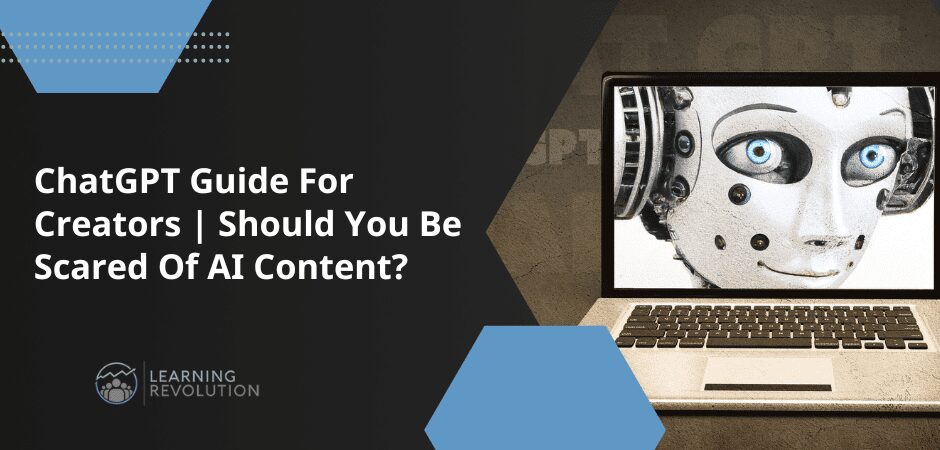
I’ll be honest.
If you’re a content creator, you’ve probably questioned your career choices more than once since OpenAI launched ChatGPT.
Using AI content, anyone can create content, online courses, eBooks, and other kinds of digital products on any topic without being an expert. It may be lower quality than a real expert, but it still increases competition and makes selling courses harder.
But should you really be scared of ChatGPT and other AI content tools? Is it a threat or an opportunity to grow your e-learning business?
In this article, we’ll take a closer look at ChatGPT and its capabilities and limitations. We’ll also discuss ways to use AI tools to enhance your content, online courses, and digital products. Plus, I’ll tell you whether ChatGPT and other AI tools can potentially replace you.
Sound interesting? Let’s dive deeper.
What Is ChatGPT?
ChatGPT is an open-source AI-powered conversational language model created by Microsoft and OpenAI. It reached its first million users in just five days and is already redefining how we view online content.
ChatGPT is trained on large data sets to predict the next word in a sentence and create human-like text conversations and content, including essays, short responses, software coding, and complex mathematical solutions. As it consumes more data, ChatGPT becomes better at predictions producing higher-quality content and more meaningful answers.
What makes ChatGPT unique is its ability to use the learnings from its existing data sets to perform tasks it isn’t specifically trained to do. This is similar to how the human mind works, where we learn the fundamentals of a field and apply them to everyday scenarios to come up with unique solutions. For example, if you know the basics of mechanical engineering, you can build and service different types of machines.
Here’s the user interface of ChatGPT.

In easier words, ChatGPT is a revolutionary AI-content engine that can authoritatively answer questions on any topic based on its data. For example, it can write essays, complete email campaigns, blog posts, long-form articles, video scripts, and numerous other types of content.
Here’s an example.
I asked ChatGPT to write a win-back email sequence for an eCommerce company. It came up with three highly engaging emails in a matter of minutes.
Here’s the first one.

Amazing, isn’t it?
Don’t confuse ChatGPT with a content spinner or any other AI-content generator that copies content from different sites and replaces the original text with synonyms to create seemingly unique content.
Because ChatGPT is much more intelligent and uses its AI-powered prediction model to build unique relationships and create new content instead of copying it from other sites. It is like having an all-knowing expert who can help you simplify complex topics and learn anything you want.
It’s not perfect and has limitations which we’ll discuss later. But it will undoubtedly change how we create and consume online content forever.
Let’s discuss more specific ChatGPT examples to better understand its capabilities.
ChatGPT Examples: What Can You Do With It?
ChatGPT can perform a wide range of actions because of its mammoth data sets. It can independently build relationships between different factors, creating new and unique responses.
If you search Twitter, Reddit, or Google, you’ll find many ChatGPT examples, including cases where it helped people write software code from scratch.
But for this article, I’ll stick to content creation, SEO, and general marketing-related ChatGPT examples.
ChatGPT Example #1: Research Audience Needs
ChatGPT can save hours of research time by helping you identify your audience’s top questions on any topic.
In this example, I asked ChatGPT to list people’s most common questions about freelance writing.

For content creators, this list can be a great starting point for researching freelance writing and what people want to learn about it.
ChatGPT Example #2: Brainstorm Keyword Ideas For SEO
ChatGPT is an excellent place to start your initial keyword research. It won’t provide you with search volume or competition data. But it can quickly generate a list of keyword ideas to kick off your research.

ChatGPT Example #3: Create Content Outlines
Ask any experienced content creator, and they’ll tell you that outlining your articles, guides, or courses is among the most critical parts of content creation. Creating the rest of your content becomes much easier if you get the outline right.
But creating an outline requires a ton of research and brainstorming. ChatGPT can simplify this step by suggesting an initial content outline on any topic that you can tailor to your needs.

ChatGPT Example #4: Write Landing Page Content
Want to quickly write landing page copy for your lead magnet? ChatGPT will do the job for you.

ChatGPT Example #5: Write Social Media Copy
To grow your social media accounts, you must consistently publish engaging content that resonates with your audience and provides them value. Doing this isn’t easy. But with ChatGPT, persuasive social media copy is just a few clicks away.
For example, I asked ChatGPT to write a Twitter thread for me.
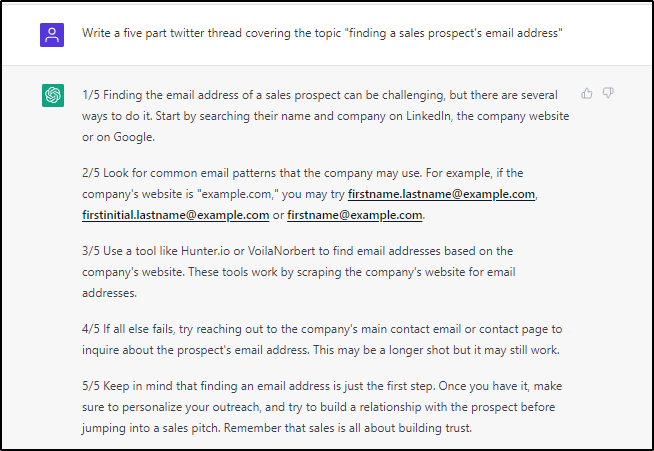
Impressive, right?
Look what it did when I asked it to write a Facebook Ad.

As you’ve seen in these examples, ChatGPT is much superior to any other AI-content tool you’ve probably used and can perform a wide range of content creation tasks.
But it has several limitations as well.
ChatGPT Limitations: Things You Must Know
ChatGPT can be surprisingly good when it comes to content creation and answering your questions. But it’s still not perfect. In fact, it has several limitations that you must understand before using it as a content creator.
Let me explain them one by one.
Limitation #1: ChatGPT Lacks Common Sense
ChatGPT relies on data to make predictions, create content, and answer questions. It learns data patterns and uses them to make new and unique decisions. But it cannot do anything outside its data’s scope.
In other words, it cannot make common sense decisions as we do even when we do not have specific information about something.
This means it does not understand the real world and might not understand human emotions, sarcasm, or references to specific cultures if its data hasn’t covered them. It might still respond to your query based on limited data, but it won’t be reliable.
This doesn’t contradict my earlier point about how ChatGPT can use the patterns from one dataset to predict the next steps in a different scenario because those decisions are still based on data.
Limitation #2: ChatGPT Requires Detailed Instructions
The quality of ChatGPT’s responses heavily relies on your instructions. Detailed and in-depth instructions will result in more refined responses. In comparison, vague or incomplete instructions will return incorrect answers.
Connect this with the previous point. ChatGPT lacks common sense and won’t know what you want until you clearly describe it.
For example, if you simply ask ChatGPT to write an article about weight loss, it will create a vague piece of content with no specific tone, target audience, or solutions.
But if you refine your instructions, the results will be different. Here’s an example of a detailed chat prompt.
Write a 1000-word article in a conversational tone, targeting women over 40, sharing specific benefits of weight loss, the dangers of obesity for women over 40, and actionable techniques to lose weight naturally in 6 months. Keep the tone light, engaging, and humorous. Use multiple subheadings and bullet points to organize the content better.
The results for this chat prompt will be much more accurate, detailed, and closer to what you want.
So, to use ChatGPT effectively, you must learn to write detailed instructions that describe exactly what you want.
Find copy/paste prompts to simplify your online course creation process using AI.
Limitation #3: ChatGPT Responses Aren’t Always Accurate
ChatGPT uses vast data sets to understand topics, build relationships, and answer questions. But it’s not always accurate and cannot be used as a direct knowledge source in most cases.
That doesn’t mean its responses are wrong or made up. But there’s always a chance of a mistake because its content is AI-generated.
For example, I asked ChatGPT to share stats about the impact of video content on SEO. Within seconds, it gave me ten seemingly authentic stats.

But when I clicked the source links, half of them didn’t exist.
Did it make up those URLs? Probably not. But the URLs didn’t exist anymore. This brings me to my next point.
Limitation #4: ChatGPT Uses Old Data
As of now, ChatGPT uses data updated till 2021. Unfortunately, this means its responses might be outdated and unreliable.
For example, those sites might have removed the URLs I showed in the previous point after 2021. But ChatGPT still uses them as a source because its data isn’t updated.
Here’s another example. When I asked it for the best movies of 2022, here’s what it said.

So, when using ChatGPT to research any topic, remember that its findings are at least a couple of years old and unaware of current world events.
Limitation #5: ChatGPT Responses Can Be Biased
ChatGPT’s responses aren’t designed to be correct or neutral. Instead, whatever it says is based on the patterns it has studied in its data set. If the data for a specific topic has built-in biases, ChatGPT’s responses will be influenced by them.
Plus, it’s also worth remembering that the tone and angle of ChatGPT’s responses directly result from how your questions are phrased.
If you ask a loaded question that includes assumptions about something, ChatGPT might answer it differently from a neutral question.
Limitation #6: ChatGPT Content Can Be Identified (Sorry, No SEO Content)
Many marketers, content creators, and freelance writers initially thought ChatGPT would become the largest source of SEO content over the next few years.
But that’s not possible for now because of two reasons.
- Google’s search guidelines clearly state that AI-generated content created solely to manipulate search results violates its policies. So, if a website copy/pastes the content from ChatGPT or other AI tools, its rankings will suffer. However, it has a better chance of ranking if the AI content is accurate, helpful, and aimed at the user instead of search algorithms.
- Secondly, ChatGPT content comes with a digital watermark, and search engines like Google can identify it from its patterns. So, if it isn’t helpful for the readers, Google can quickly penalize it for low quality. Google might also introduce new policies to prevent the mass usage of unauthentic AI content.
How To Use ChatGPT And AI Content As An Online Course Creator
ChatGPT’s content isn’t perfect, as seen in the previous section. So, instead of replacing your existing content creation process, use ChatGPT to assist you.
You’re still the real-world expert with first-hand experiences and domain knowledge. ChatGPT can’t replace that for now. But it can churn out first drafts much faster. From there, improve it with your insights, expertise, and unique knowledge and turn that rough draft into a sellable piece of content.
Let’s discuss ways you can use it to improve and accelerate the process of creating, managing, and promoting your online courses, membership sites, and other types of digital products.
1. Get A Step-By-Step Course-Launch Plan
Launching an online course is a multi-step process that requires careful planning and execution. If you’re unsure how to launch your course, just ask ChatGPT for help.
It will give you a high-level launch plan for any digital product.
Here’s an example.

If you want more specific insights, you can ask ChatGPT about each step of the process separately.

Want to be more specific? Here’s another example.

In short, you don’t need to guess through any step of your course creation and launch process when you have ChatGPT to guide you.
2. Beat Creator’s Block
Writer’s block is real, and so is creator’s block. But with ChatGPT, you don’t need to spend hours staring at a blank document and wondering what to write.
If you struggle to write content for your course lessons, use ChatGPT to quickly generate a rough first draft and get your creative juices flowing.
Here’s an example.
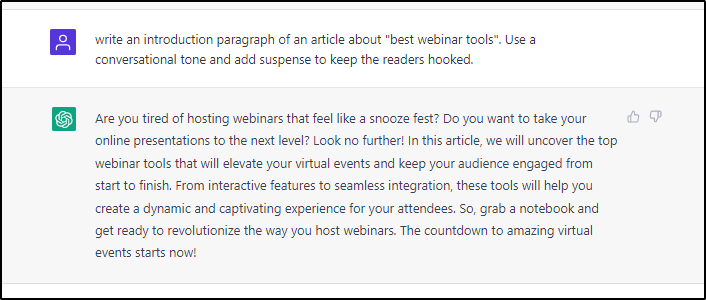
Need tips for a video introduction? ChatGPT has got you covered.

In short, whenever you feel stuck in your content creation process, use ChatGPT to get things moving.
3. Develop Your Market Research Plan
Understanding your target audience’s needs, wants, fears, and aspirations are critical for creating actionable online course content. ChatGPT can speed up your market research process and help you uncover unique audience insights.
For example, here’s a high-level market research plan for an online course.

Some great ideas in there.
You can also get ready-to-use templates for your market research process. For example, ChatGPT created this excellent buyer persona template I can use for customer profiling.

And if you’re unsure how to perform a specific research task, ChatGPT can guide you at every step.

In short, ChatGPT can answer most of your research-related questions and help you gain valuable audience insights.
4. Create Detailed Course Outlines
A course outline lets you effectively plan, manage, and execute your course creation. But if you’re struggling to create an outline from scratch, just ask ChatGPT for a sample outline.
Here’s an example.

Once you have the course outline, you can tailor it to your needs and add/remove lessons or change their order depending on your goals.
5. Write Video Scripts
Creating video scripts is one of the best ways to use ChatGPT for online courses. Why? Because video script creation is a critical but tedious process that takes a long time, especially if you’re creating your first course.
With ChatGPT, you can create complete video scripts with transitions and instructions within seconds.
Here’s an example.

To get more accurate results, you can focus on specific headings or topics in your video and describe the tone and style of content depending on your audience.

As you can see, with refined instructions, ChatGPT created a more accurate and engaging script.
6. Write Quizzes For Your Course
Quizzes make your course more engaging and help evaluate your students’ performance. But designing quizzes can be a time-taking process.
Once again, ChatGPT is there to help you.
Look at this sample quiz it created for me in just a few seconds.

You don’t have to use all those questions. But it gives you a lot of ideas and allows you to set up engaging quizzes according to your student’s skill level.
7. Build Your Email Marketing Strategy
Email marketing is critical to your course’s marketing, sales, and user engagement. ChatGPT is like always having a personal email marketing consultant with you.
Don’t believe me? Just ask it to recommend the best email sequences for your course.

Impressive, right? Now choose the best sequences for your course and then ask ChatGPT to break down each sequence in more detail.
Here’s an example.

Amazing, isn’t it? Now you know what emails to include in a Welcome sequence. But let’s move one step ahead and ask ChatGPT to write these emails for you.

There you go. Just edit this email to match your audience’s interests and add it to your email marketing software.
Follow the same process for all the email sequences you want, and you’ll have your complete email strategy in place in no time.
You can do so much more with ChatGPT, but these examples offer ideas on using it to grow your business.
Again, the quality of ChatGPT’s responses depends on your input. So make sure you give detailed instructions that describe exactly what you want from it.
The Best AI Content Tools For Creators
Before winding up this article, let’s look at some of the best AI content tools for creators. These products are reshaping the online content landscape and giving creators new and better ways to grow and engage their audiences.
1. OpenAI
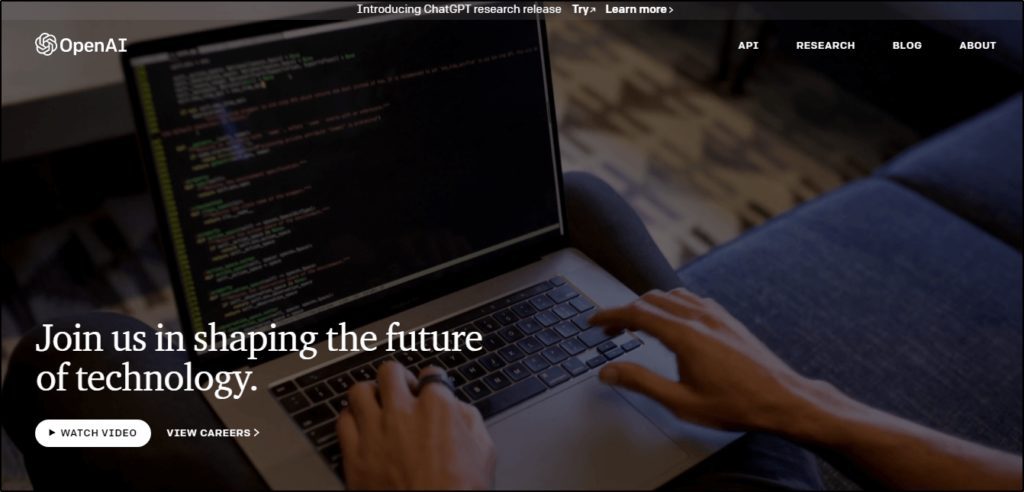
OpenAI is the company behind ChatGPT and Dall.E.2, a revolutionary AI image creator. Backed by Microsoft and several other heavyweight investors, OpenAI’s ChatGPT is an open-source AI chatbot capable of having human-like conversations and producing a wide range of content, including articles, landing pages, emails, templates, social media copy, ad copy, and numerous other content types.

2. Jasper.AI
Jasper is among the top AI content generators explicitly designed for writers, authors, copywriters, marketers, and creators. It has ready-to-use templates for various content types, including blog posts, social media posts and ads, landing pages, and website and email copy. You can also use open-ended commands to write content with Jasper. Like most other AI content tools, Jasper’s output quality heavily relies on the quality of your instructions. With descriptive and detailed prompts, Jasper produces better results.
3. Copy.AI
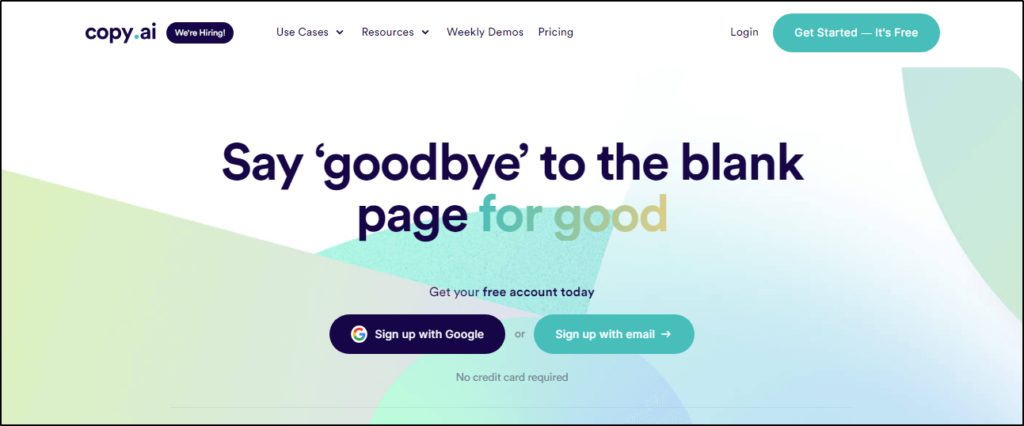
Copy.AI is another excellent content generator that uses AI to help you beat writer’s block and create content 10x faster. It’s not as sophisticated as Jasper but still produces high-quality blog posts and web content on any given topic.

4. Rytr
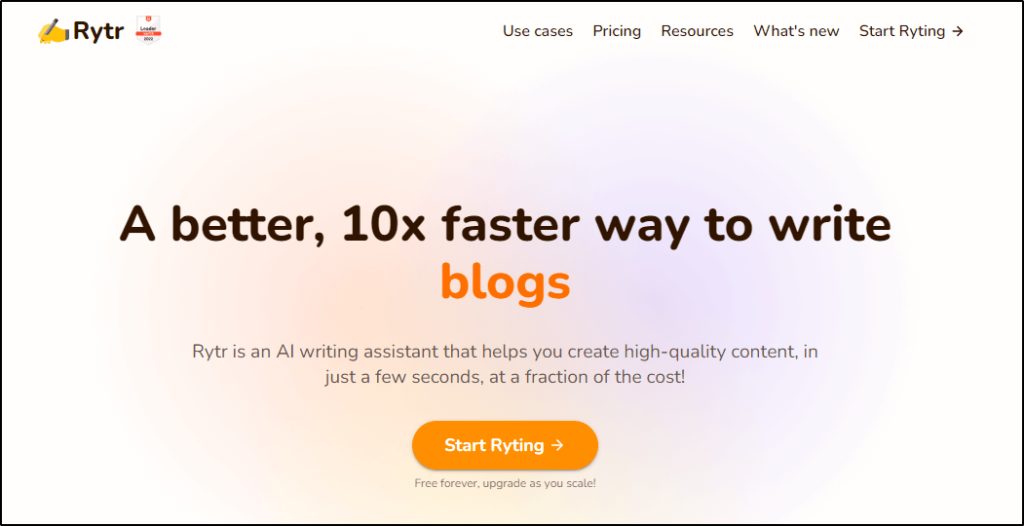
Rytr is a leading AI content tool that allows you to write blog posts, social media content, job descriptions, product descriptions, and various other content types in 30+ languages.
You can choose your content’s tone to make it passionate, conversational, funny, professional, or any other style that resonates with your audience.
Plus, once you generate content with Rytr, it provides a complete document editing and management system to edit and share your work with your teammates.

5. Anyword
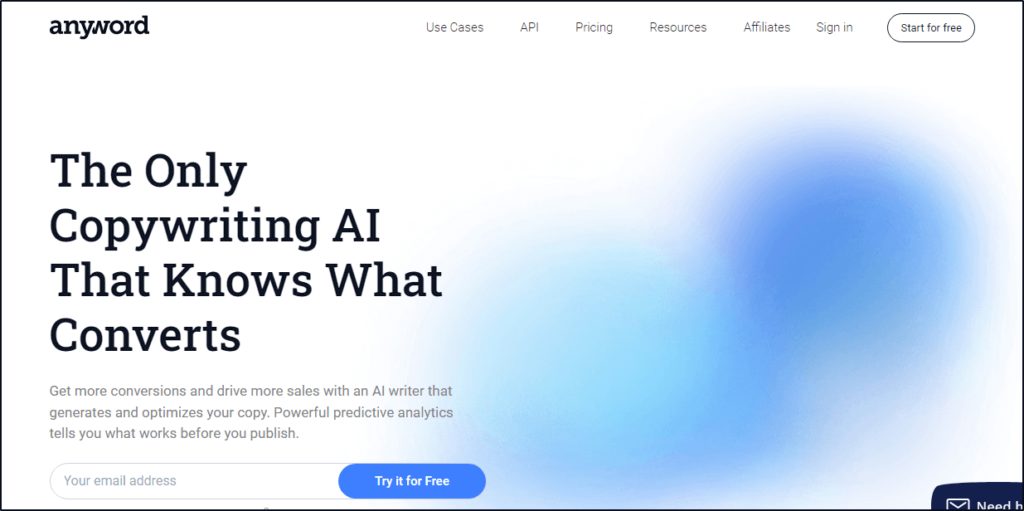
Anyword is a conversion-focused AI content generator that writes excellent content and tells you how your target audience would respond to it. It rates every piece of content with a conversion score to help you understand if it will drive results.
With Anyword, you can create persona-specific content by telling it about your target audience and generating tailored content. It also tells you how your content will perform for different demographics so that you can use it in the right place.

Ready To Use ChatGPT And AI-Content For Your Online Course?
AI content isn’t a creator’s enemy. Instead, tools like ChatGPT can simplify your job and allow you to produce better content faster. You’re still the expert with unique experiences and perspectives that AI does not have.
So, start playing with ChatGPT (if you haven’t already) and use the techniques I’ve shared in this article to create more valuable content.
If you have any questions, just shoot them in the comments section.
By Jawad Khan for Learning Revolution
See also:
Table of Contents
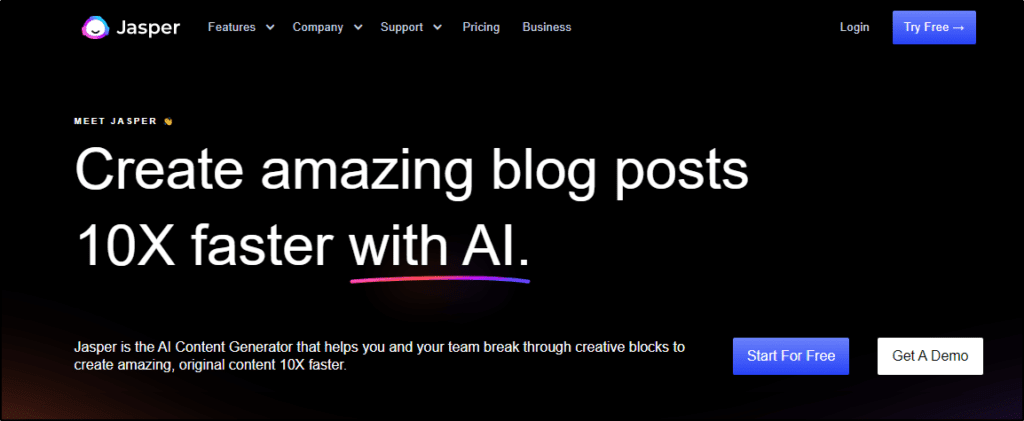


Related Posts
21+ Best ChatGPT Prompts for Course Creators [With Examples]